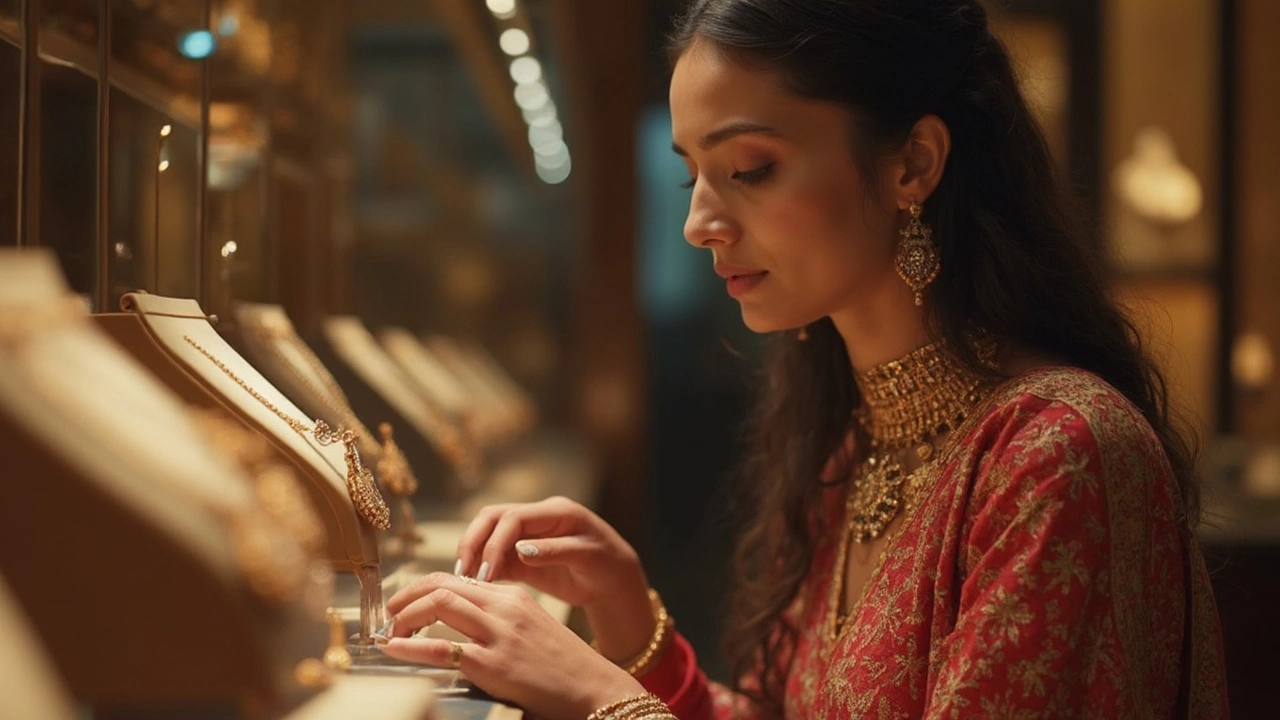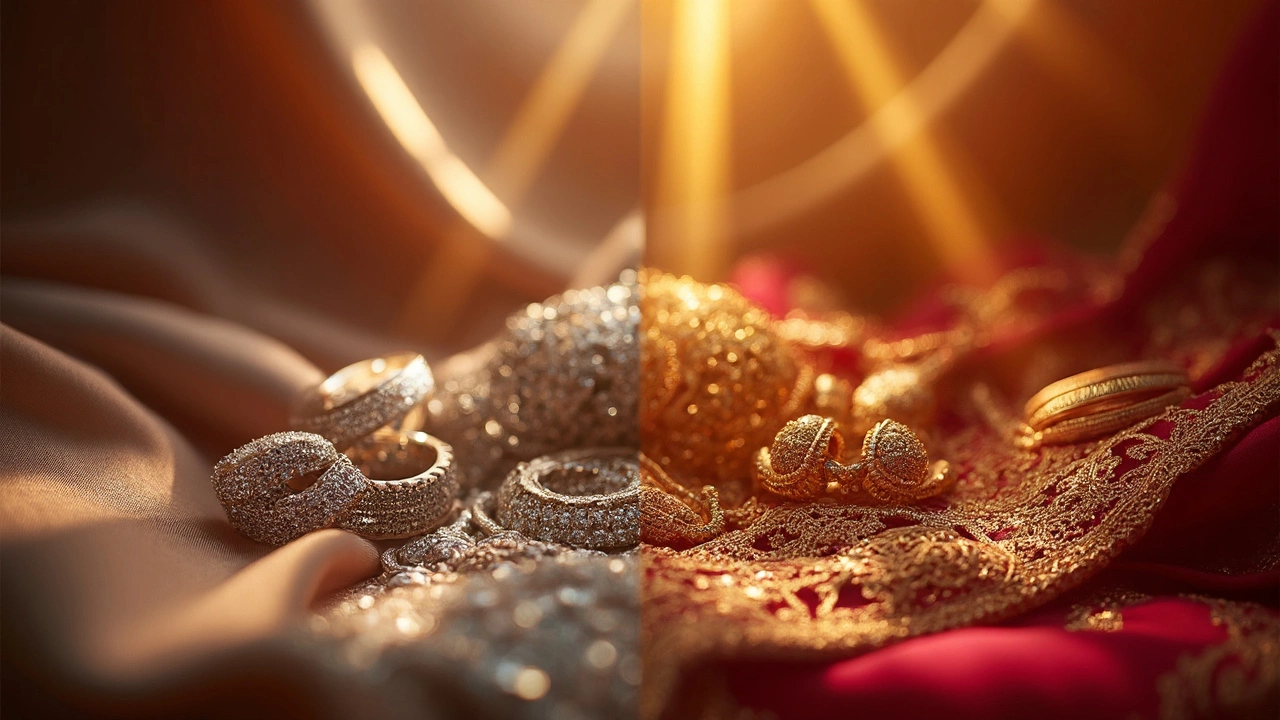The next time you’re eyeing a sleek necklace or savvy wedding ring, there’s a good chance you’ll end up torn between platinum and gold. You’ve probably heard that platinum is fancier, but is it actually better? There’s more to this choice than just the price tag at the store.
Let’s get real: most people think gold wins for tradition, and platinum wins for lasting forever. The truth runs deeper. Platinum’s color never fades, but it scuffs up fast if you don’t like that matte look. Gold has different shades, which means you can match it to your vibe easier. And here’s something my daughter Pari pointed out after rubbing her wrist for an hour—gold jewelry can sometimes make skin itchy if you’re sensitive. That’s not something the sales guy tells you.
If you want a ring that takes a beating—maybe you work with your hands or, like my son Dhruv, you’re always opening boxes or wrestling with gadgets—how well do these metals hold up? Gold is softer than platinum, so it does pick up scratches, but platinum gets those dents too, just in a different way. And the price difference? It’s not just hype or status. It comes down to rarity, weight, and the real cost of keeping it looking sharp over the years. So if you’re weighing options for your next jewellery splurge, let’s break down what really matters.
- What Makes Platinum and Gold Different?
- How Each Metal Handles Daily Wear
- Allergic Reactions: Is One Safer?
- Cleaning and Maintenance
- Price: Is Platinum Worth the Extra?
- When to Choose Gold or Platinum
What Makes Platinum and Gold Different?
Let’s cut through the noise: platinum and gold aren’t just two shades of the same story. They’re different metals, and that affects everything from price to how they look in the real world. First off, platinum vs gold isn’t just about color. Platinum is naturally white, kind of a cool, silvery tone, while gold by itself is a warm yellow. If you see white gold, it’s actually yellow gold mixed with other metals and usually covered with rhodium to make it look whiter. That white coat wears off with time, so white gold needs touch ups. Platinum keeps its color forever—no re-coating needed.
Both metals are heavy, but platinum takes the crown for density. If you’ve ever held a platinum ring next to a gold one, the platinum just feels heavier on your hand. That’s not your imagination—it genuinely is denser, which can make jewellery feel a bit more solid. On the flip side, gold is much easier to shape into thin designs and detailed patterns; that’s why you’ll see so many unique gold jewellery designs in stores.
Here’s a quick breakdown of differences that matter when you’re shopping:
- Color: Gold comes in yellow, white, and rose versions. Platinum stays one steady shade of silvery white.
- Purity: Platinum jewellery is usually 95% pure. Gold jewellery in India is often 22K (about 91% pure) for traditional stuff or 18K (75% pure) for daily wear, as pure gold is too soft for practical pieces.
- Rarity: Platinum is rarer than gold—much rarer. That’s one reason it’s pricier.
- Hypoallergenic: Platinum is less likely to cause skin irritation. Gold mixes with other metals, which can sometimes bug sensitive skin.
- Wear and tear: Platinum stands up to daily abuse, but shows scratches as a soft patina. Gold, especially the higher karats, is softer and can bend over time.
If you want classic looks or intricate details, gold is usually your best friend. If you want something that’s heavy, keeps its color, and works for sensitive skin, platinum stands out. Knowing these differences helps you shop smarter, not just pricier.
How Each Metal Handles Daily Wear
It doesn’t matter if you’re wearing your ring for a wedding, a party, or just running errands—jewellery gets banged up more than you think. So how do gold and platinum actually survive your daily routine?
Here’s what really happens: gold is a soft metal, and the lower the karat, the tougher it is. For example, 18k gold jewellery is stronger than pure 24k because it’s mixed with tougher metals. But even then, gold gradually wears away when scratched. Every little scrape actually removes a tiny bit of gold. Platinum’s different. It’s softer in feel, but when you scratch it, the metal just shifts; it rarely chips off. So, over time, platinum pieces might develop a patina—kind of a dull, matte finish instead of that store-bought shine.
| Gold (18k) | Platinum | |
|---|---|---|
| Scratch Resistance | Moderate (scratches over time, metal slowly wears off) | Good (shows scratches, but metal remains, forms patina) |
| Color Fading | May fade or discolor (especially white/rose gold) | Color stays the same |
| Resizing/Easy to Repair | Easy (jewelers work with gold every day) | Harder (fewer specialists, more expensive) |
With platinum vs gold, there’s no simple winner for daily wear. Gold holds up well for light, careful wear (like if you mainly work at a desk), and you can polish or repair it easily. Platinum takes a beating and doesn't lose much metal even after years. That’s why people sometimes choose platinum for things like wedding rings that never come off.
Worth noting: platinum jewellery is heavier than gold—if you’ve worn both, you’ll notice the difference. Some folks love that “solid” feeling, others find it kind of chunky. Also, white gold is often coated with rhodium for extra shine, but after months of use, the coating can wear off and you might need to re-plate it.
If you know you’re rough on your jewellery, or you just hate fussing with upkeep, platinum wins for low maintenance durability even if it shows bumps and bruises faster.
Allergic Reactions: Is One Safer?
Allergic reactions from jewellery can be a total mood killer. The big question is whether platinum or gold is safer for folks with sensitive skin. Here’s the straight truth: platinum is usually the winner for skin safety. Pure platinum jewellery is about 95% platinum, mixed with tiny amounts of other harmless metals like ruthenium, so the risk of a reaction is super low.
Gold, on the other hand, is almost never pure unless you’re splurging for 24-karat, which is pretty soft for daily wear. Most gold jewellery is 14K or 18K, which means it’s mixed with other metals—usually nickel, copper, or silver. Nickel is the main villain when it comes to rashes, redness, and itching. This isn’t rare—plenty of people find a new ring or chain just doesn’t love their skin back.
If you or your kids have a history of metal allergies, platinum is a safer bet. In fact, some doctors even recommend platinum wedding bands for people who can’t handle other metals. If you still want gold, you can ask for hypoallergenic alloys that skip the nickel, but double check—some brands cut corners.
- Ask jewellers about exact metal content, especially for gold.
- Look for platinum pieces marked "950" or "PT950" which means 95% pure platinum.
- If you do get a rash, switch hands or take off the piece for a few days. If it keeps coming back, go see a doctor and try another metal.
Bottom line: platinum is usually trouble-free if you don’t want to risk skin drama. With gold, do your homework or talk to the jeweller—especially if you have young kids who love borrowing your jewellery for playtime.

Cleaning and Maintenance
If you’re thinking about which metal will give you less hassle in the long run, the way you’ll clean and care for platinum and gold really matters. Both are pretty easy to maintain if you keep up with the basics, but there are a few key differences you should know.
Gold jewellery—especially if it’s the classic 22K or higher—can be scratched fairly easily. That means it can lose some shine with day-to-day bumps. Cleaning is simple, though: just use a bowl of mild soapy water, a soft toothbrush, and a gentle rinse. Dry with a soft cloth. Stay away from bleach or harsh chemicals; they can pit the metal. And bear in mind, if your jewellery is gold jewellery with stones, double-check that water won’t mess with the setting.
Platinum gets a lot of hype for its durability, but here’s a surprise: it develops something called a “patina” over time. That’s jeweller-speak for a worn matte look. Some love it because it feels vintage; if you prefer shiny, you’ll have to hit the jeweller now and then for a professional polish. For day-to-day cleaning, you can use soapy water and a soft brush, just like with gold.
Let’s compare basic cleaning at home:
- Soak the piece in warm water mixed with a splash of dish soap for 20-30 minutes.
- Use a baby toothbrush (super soft) to scrub light dirt off.
- Rinse under clean water and dry with a lint-free cloth.
If your jewellery has diamonds or gems, try not to submerge them too often—just wipe gently with a wet cloth instead. Check clasps and settings every few months, especially for gold pieces, to make sure nothing’s coming loose.
Here’s a quick data table comparing hassle factors:
| Feature | Gold | Platinum |
|---|---|---|
| Needs Frequent Polishing? | Yes (if you want extra shine) | Less often, but needed for shine |
| Prone to Scratches? | More than platinum | Scuffs but is tougher overall |
| Develops Patina? | No | Yes, matte finish over time |
| Basic Cleaning | Soapy water, soft brush | Soapy water, soft brush |
| Specialist Care | Every 1-2 years | Every 1-2 years (for re-shining) |
I’ve found that tossing a soft cloth in your jewellery box is a lifesaver, especially for gold. Give your rings a quick wipe when you take them off for the night. And if your kids are anything like mine, who once redecorated my chain with peanut butter, keep your jewellery away from sticky hands—or at least know that both metals will bounce back with a little TLC.
Price: Is Platinum Worth the Extra?
Alright, let’s talk numbers. Anyone who’s ever checked the price tag at a jewellery shop knows platinum almost always costs more than gold. That’s not because of a brand gimmick—it’s because platinum is rarer, denser, and heavier. A platinum ring often weighs 30-40% more than a similar gold ring, so you’re paying for more of the metal, not just shinier marketing.
Here’s a quick look at what this looks like today (as of June 2025):
| Metal | Price Per Gram (INR) | Typical Purity |
|---|---|---|
| Platinum | ~₹3,450 | 95% |
| Gold (22K) | ~₹6,500 | 91.6% |
You’re probably thinking, "Wait, so gold costs more per gram?" Yep! But remember, platinum pieces weigh more, and you almost always get 95% pure platinum in jewellery, while gold is often mixed (alloys) to make it stronger. So, a platinum ring feels heavier and adds up to more grams and a bigger bill.
"Platinum is about 30 times rarer than gold in the Earth’s crust," according to the World Platinum Investment Council.
But is platinum vs gold worth it long-term? Platinum sure holds up well—it doesn’t wear away as fast and rarely needs to be replaced, just repolished if you want it to shine. Gold scratches are easier to polish out at home, while platinum needs a pro. If you ever need to resize a platinum ring, though, prepare for a bigger bill because platinum’s melting point is much higher and fewer jewellers will take up the job.
- For expensive designer jewellery, platinum almost always boosts the sticker price.
- If resale value is your main concern, gold is easier to sell. Banks and jewellers love it.
- Platinum’s price can swing more in the market—the supply is smaller and more volatile.
If your move is about making an investment, gold gives you more flexibility and instant liquidity. If it’s about strength, weight, and that "forever metal" vibe, platinum might be worth the splurge—just know you’re not getting a deal, you’re getting a status piece. The decision comes down to what you value more: tradition, money, or standing out from the crowd.
When to Choose Gold or Platinum
Picking between gold and platinum? Take a second to figure out what matters most to you—budget, durability, looks, or even skin comfort. Here’s some practical advice, straight from what actually happens when you wear these metals in daily life.
Most people still choose gold for classic pieces like wedding bands and family heirlooms. Gold comes in more colors (yellow, white, and rose), so it’s easy to match your jewelry to your style or skin tone. It’s also softer and easier to resize. If you plan on changing the size of your ring later or you like switching up designs, gold is just less hassle.
On the flip side, platinum wins for long-term toughness. It’s heavier and more durable, so engagement rings and pieces you never take off (like wedding bands) might make more sense in platinum, especially if you’re rough with your hands. Plus, platinum rarely causes allergies—it’s about 95% pure, compared to white gold, which is usually mixed with nickel or other metals that could bother sensitive skin.
To keep things simple, here’s a quick table to sum up where each metal shines:
| Factor | Gold | Platinum |
|---|---|---|
| Color Options | Yellow, White, Rose | Natural White-Gray Only |
| Durability | Scratches easier, but refinishes well | Extremely durable, shows less wear but develops patina |
| Allergy Risk | Sometimes, due to alloys | Very rare |
| Maintenance | Needs re-plating for white gold, resizes easily | Low maintenance, resizing is tougher |
| Cost (as of 2025) | $70/g (24K) | $105/g |
When should you pick gold? Go for it if you want more style choices or have a tighter budget. Gold’s usually lighter, so big bangles and chunky chains cost less when they’re gold.
Want something you never have to take off—no matter if you’re swimming, sleeping, or playing rough? Go with platinum. It’s the platinum vs gold debate at its core: tradition and style for gold, strength and hypoallergenic for platinum.
If you still can’t decide, try this: what’s the piece for? For daily wear and extra toughness, pick platinum. For gifts, family keepsakes, or colorful designs, gold is a smart choice. Either way, check with your jeweler on things like free resizing, maintenance plans, and how your jewelry will actually hold up in your real life—not just behind a glass case.



